“The majority of PTAB judges who responded [to the GAO survey] reported feeling pressured ‘to adhere to management comments and to change or modify an aspect of their decision for an [AIA] trial on challenges to the validity of issued patents.’”
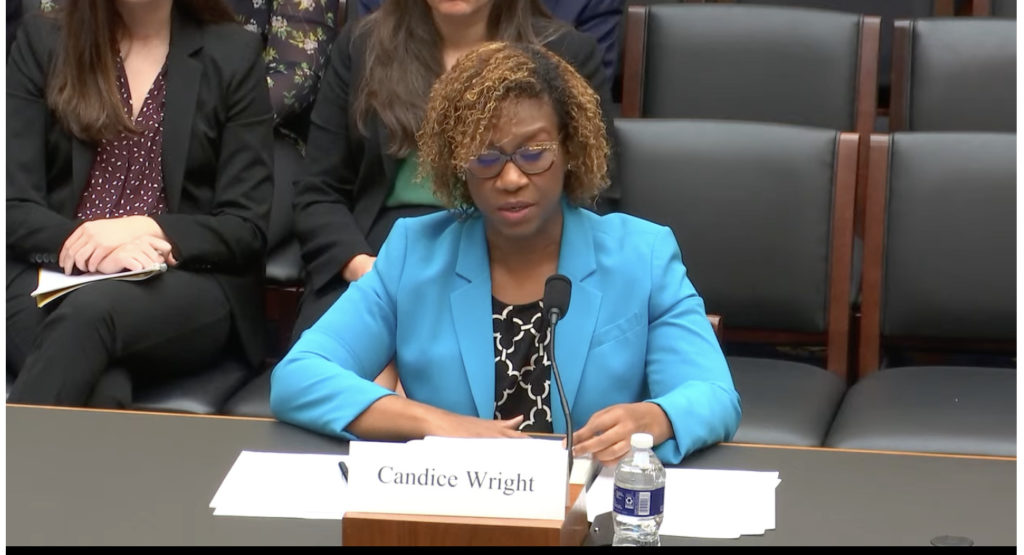 The House Judiciary Committee’s Subcommittee on Courts, Intellectual Property, and the Internet today held Part II in a series of hearings to consider reforms to the Patent Trial and Appeal Board (PTAB) 10 years after it was created by the America Invents Act (AIA). The hearing, titled “The Patent Trial and Appeal Board After 10 Years, Part II: Implications of Adjudicating in an Agency Setting,” coincided with the release of a preliminary report by the U.S. Government Accountability Office (GAO) that was commissioned in June of last year by IP Subcommittee Chair Hank Johnson (D-GA) and Ranking Member Darrell Issa (R-CA) to investigate PTAB decision-making practices. The GAO’s preliminary findings revealed that “the majority of [administrative patent] judges (75 percent) surveyed by GAO responded that the oversight practiced by U.S. Patent and Trademark Office (USPTO) directors and PTAB management has affected their independence, with nearly a quarter citing a large effect on independence.”
The House Judiciary Committee’s Subcommittee on Courts, Intellectual Property, and the Internet today held Part II in a series of hearings to consider reforms to the Patent Trial and Appeal Board (PTAB) 10 years after it was created by the America Invents Act (AIA). The hearing, titled “The Patent Trial and Appeal Board After 10 Years, Part II: Implications of Adjudicating in an Agency Setting,” coincided with the release of a preliminary report by the U.S. Government Accountability Office (GAO) that was commissioned in June of last year by IP Subcommittee Chair Hank Johnson (D-GA) and Ranking Member Darrell Issa (R-CA) to investigate PTAB decision-making practices. The GAO’s preliminary findings revealed that “the majority of [administrative patent] judges (75 percent) surveyed by GAO responded that the oversight practiced by U.S. Patent and Trademark Office (USPTO) directors and PTAB management has affected their independence, with nearly a quarter citing a large effect on independence.”

GAO Finds PTAB Judges Feel Pressure to Conform to Management Views
According to the report, the GAO surveyed “all 234 non-management and lead PTAB judges and achieved an 87 percent response rate. GAO also interviewed stakeholders—including parties to PTAB proceedings, and current and former judges—and PTAB officials.” The majority of judges who responded reported feeling pressured “to adhere to management comments and to change or modify an aspect of their decision for an America Invents Act (AIA) trial on challenges to the validity of issued patents.” In his opening remarks at today’s hearing, Issa said these preliminary results warrant potentially reversing or setting aside decisions made under the last USPTO administration. Issa explained:
“We [asked for the GAO investigation] because we had allegations but not substantiation. In looking at the preliminary report I find the GAO’s investigation to be disturbing – they indicate that bureaucrats in the agency leadership, led by the Director himself, have improperly influenced or altered decisions by PTAB judges in secret without transparency and, in my opinion, without due process…. In those cases, the parties involved had no idea the Director was meddling in their case…. We have a process for making rules – those rules are subject to review by Congress…. As we go through the GAO study, it is likely we’ll speak to the new director about reversing some of these or setting them aside simply because they violated the current law on rulemaking.”
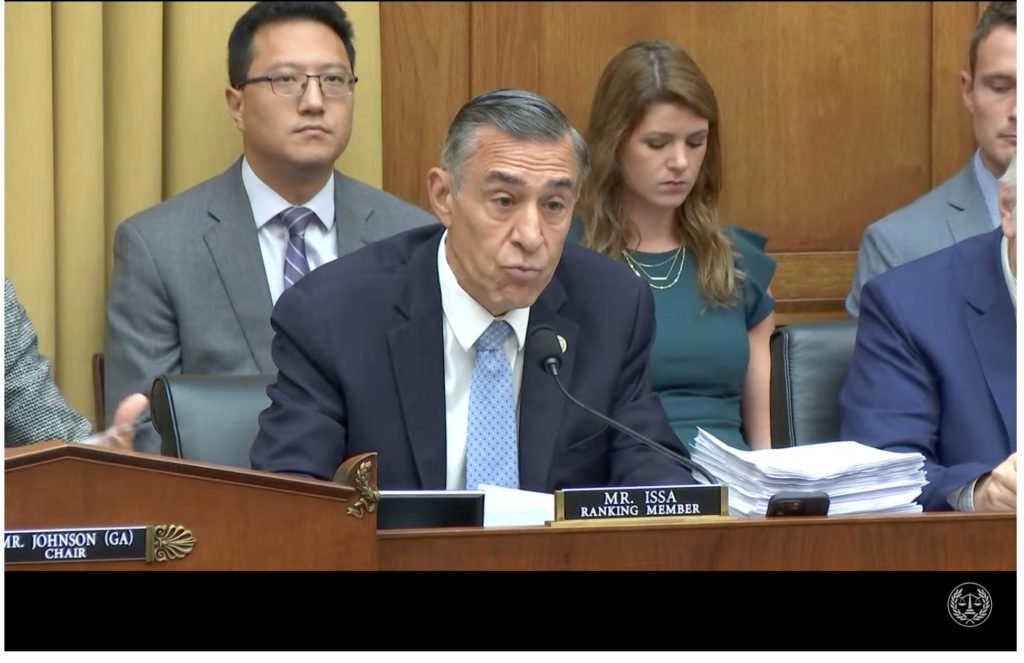 Issa presented a large stack of “just some” of the decisions he believes were improperly made.
Issa presented a large stack of “just some” of the decisions he believes were improperly made.
One of the witnesses at the hearing was Candice Wright, Director, Science, Technology Assessment, and Analytics Team, U.S. Government Accountability Office, who presented the GAO’s preliminary findings. She said that while “oversight typically did not influence the merits of the case…there can be pressure on discretionary areas driven by agency policy or guidance.” Wright added that even for judges whose cases were not subject to management oversight, stories about other judges who had been could have a “preemptive chilling effect” on judicial independence, although she later stated that none of the judges interviewed admitted to actually changing their decisions due to these influences.
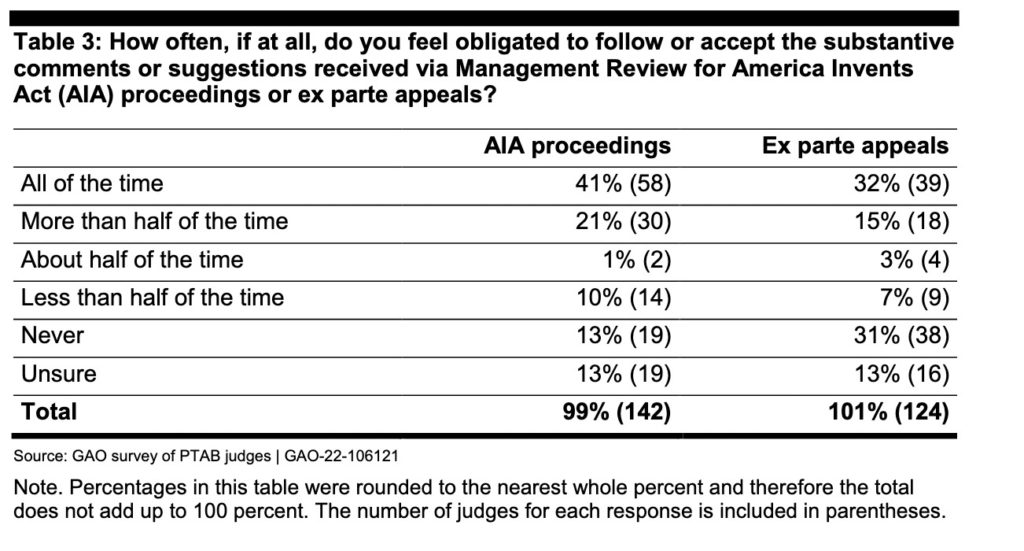
The report also indicated that judges felt “director-created policy and guidance had an effect on their ability to decide cases independently.” As an example, some judges interviewed thought former USPTO Director Andrei Iancu’s guidance on subject matter eligibility “was inconsistent with relevant case law.” The report explained:
“Sixty judges (30 percent) we surveyed responded that, in their opinion, the PTAB 2019 Revised Patent Subject Matter Eligibility Guidance creates new tests for evaluating whether an invention is eligible that are not supported or established by the applicable case law. Sixty-three judges (31 percent) responded that it did not create new tests and 80 judges (39 percent) had no opinion. One judge stated that, ‘the guidance memos from the director, the precedential decisions, the Management Review process, and the AIA review process significantly limit the panel to write as we see fit. We are obliged to follow the guidance memos as if they are applicable law,’ while another judge stated that ‘Management Review is by far the most significant factor’ affecting their independence.”
As to the external stakeholders the GAO interviewed, they were generally unaware of director/ management oversight processes and expressed concerns about transparency. Wright also noted USPTO Director Kathi Vidal’s recent interim update to PTAB decision circulation and internal review processes, which she said was “a good step forward to address the concerns of judges and stakeholders.”
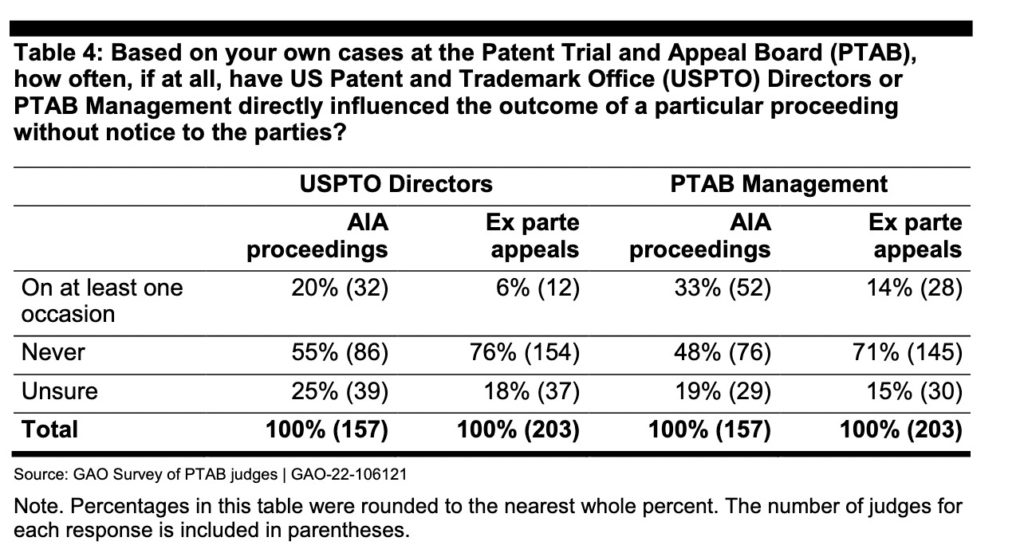
Witnesses: How We Got Here and What to Do
The other witnesses at today’s hearing were Richard Torczon, Senior Counsel, Wilson Sonsini Goodrich & Rosati, who formelrly servied as an APJ; James Donald Smith, Chief Intellectual Property Counsel, Ecolab, who served as the first Chief Judge of the PTAB and as former Board of Patent Appeals and Interferences (BPAI) Chief Judge; and Michael Asimow, Deans Executive Professor of Law, Santa Clara University School of Law.
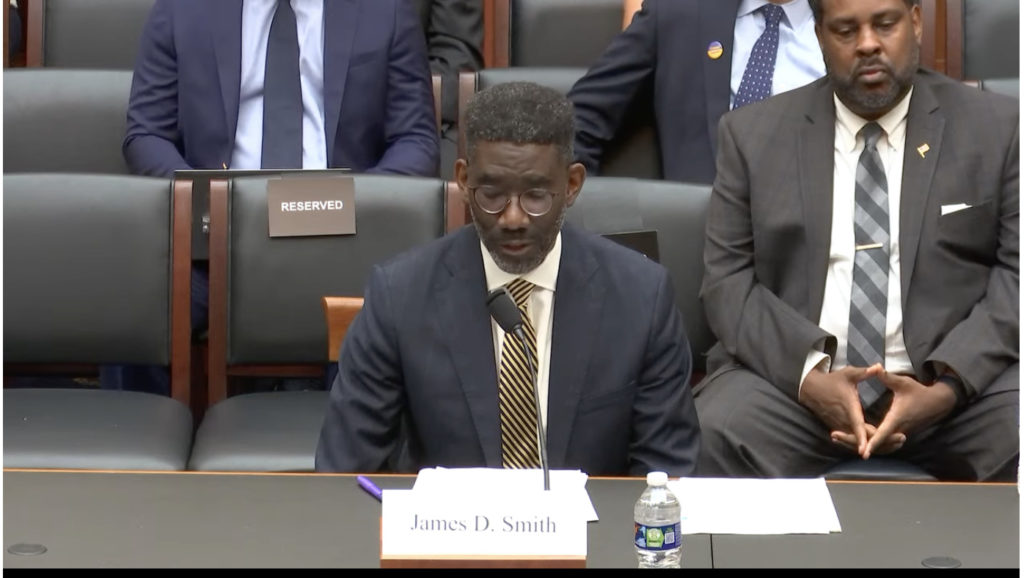 Smith explained how the transition to the PTAB overwhelmed the 90 APJs at the time, who were tasked with reducing a backlog of 27,000 appeals carried over from the BPAI on top of 1,500 new trials each year—a number nearly four times the estimated 400 new trials anticipated during AIA passage. As a result, former USPTO Director David Kappos managed to get permission to expand the PTAB judges by 150 APJs. During the hiring process, Smith said the one question every candidate was asked was what they would do if the USPTO Director or other official pressured them to change their opinion in a case they were working on due to political considerations. “Every one of the judges who we advanced for nomination answered that question only one way,” Smith said. “[They responded] ‘we will ask whoever is asking us to change our decision to leave because we believe in judicial independence and due process and the Director has other means, including through rehearing, for the case to be reviewed.’ All of the candidates who said they would do whatever the Director told them to do were not advanced.”
Smith explained how the transition to the PTAB overwhelmed the 90 APJs at the time, who were tasked with reducing a backlog of 27,000 appeals carried over from the BPAI on top of 1,500 new trials each year—a number nearly four times the estimated 400 new trials anticipated during AIA passage. As a result, former USPTO Director David Kappos managed to get permission to expand the PTAB judges by 150 APJs. During the hiring process, Smith said the one question every candidate was asked was what they would do if the USPTO Director or other official pressured them to change their opinion in a case they were working on due to political considerations. “Every one of the judges who we advanced for nomination answered that question only one way,” Smith said. “[They responded] ‘we will ask whoever is asking us to change our decision to leave because we believe in judicial independence and due process and the Director has other means, including through rehearing, for the case to be reviewed.’ All of the candidates who said they would do whatever the Director told them to do were not advanced.”
Asimow commented that all of the PTAB’s problems arise from the “defective structure of the PTAB when created,” specifically that there was no clear appellate review structure. He later suggested that one legislative fix could be to consider a tribunal similar to that of the Tax Court, which exists independently of the Internal Revenue Service (IRS), for example. This would be “an independent adjudicating entity in which the Director could become a party and could appear on the side of either litigant, but otherwise would not be controlled by the PTO at all,” he explained.
As a former APJ, Torczon told the Subcommittee members in response to questions about why existing prohibitions on ex parte communications with APJ panel members did not seem to be working that, “as the person who drafted the rule in question, I can assure you that it has never been viewed as having internal application.” Torczon said that, while the number of cases in which such interference takes place is relatively small, “it’s a real problem where it is happening, and it has a chilling effect.” He provided an example from his own experience at the Office in which he said one of the judges on a panel he was part of was a management official and, after indicating that he would dissent, “the next thing I knew the case was handed to another panel.” Torczon said the problems at the USPTO are ultimately ones of “culture” and that “a culture reset” via legislative intervention is necessary.
For his part, Smith disagreed with Torczon that the ex parte communications prohibition did not apply internally, and said that the creation of bodies such as the AIA Review Committee (ARC) was not meant to be an ex parte communication or interference by judges into a case, but rather was intended “to drive uniformity in the written output of the Board.”
Massie Wants the PTAB Gone for Good
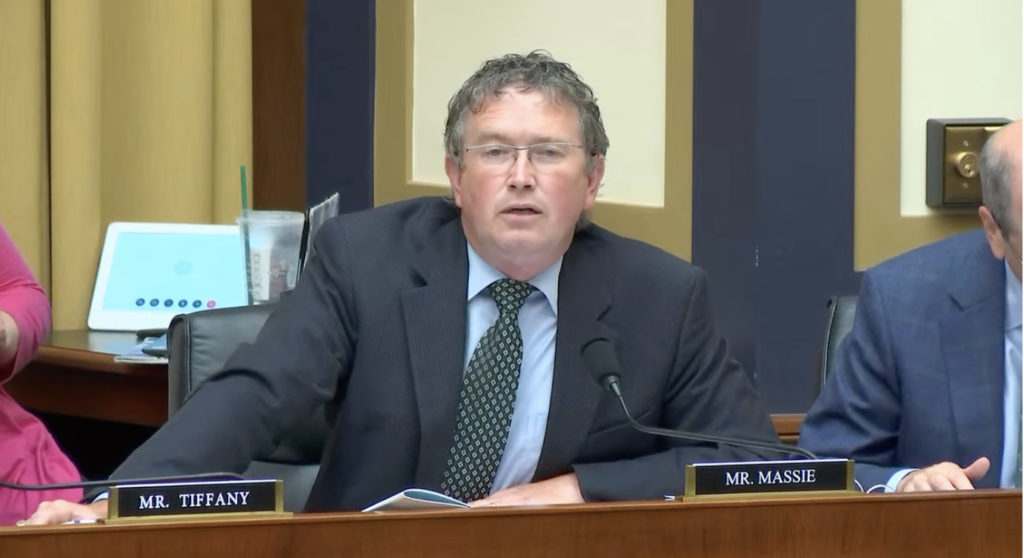 Representative Thomas Massie (R-KY) continued to advocate for eradicating the PTAB altogether, suggesting that if he had been around for the AIA hearings, he might have introduced an amendment to rename the AIA “’the Seventh Amendment Repeal Act’ because this thing that’s in our Constitution that’s a right to a jury trial has been suspended by the AIA.” Massie said that as long as the PTAB remains in place, Congress will continue to meet every four years wondering why the system is corrupt and how independence was lost:
Representative Thomas Massie (R-KY) continued to advocate for eradicating the PTAB altogether, suggesting that if he had been around for the AIA hearings, he might have introduced an amendment to rename the AIA “’the Seventh Amendment Repeal Act’ because this thing that’s in our Constitution that’s a right to a jury trial has been suspended by the AIA.” Massie said that as long as the PTAB remains in place, Congress will continue to meet every four years wondering why the system is corrupt and how independence was lost:
“It seems like we’re struggling with this problem because we took something that belongs in the judicial branch and stuck it in the most political branch there is…. Congress is very political, but at least there’s some Republicans and some Democrats at all times…. All of these problems get solved if you do one thing—put it back the way it was. Otherwise, we can patch this PTAB up, but we’re gonna be here in four more years wondering how the system got corrupted, how independence was lost, and why inventors are getting messed over and they have no way to appeal it.”
Massie introduced the Restoring America’s Leadership in Innovation Act of 2021 last year, which would in part repeal the PTAB, return the patent system to a “first-to-invent” model, rather than first-to-file, and would end automatic publication of patents. To support his views Massie introduced several articles for the record, including two IPWatchdog posts: “How Google and Big Tech Killed the U.S. Patent System” and “USPTO Response to FOIA Confirms There are No Rules of Judicial Conduct for PTAB Judges.”
But Issa repeatedly hit back at Massie throughout the hearing on his assertion that going back to the old system would be any better. “Yes, we might be here again in four years, but this is a process that has evolved because of past problems,” Issa said in his closing remarks.
However, all of those present seemed to agree that some legislative solution was necessary to ensure transparency and judicial independence at the Office, particularly in light of the GAO’s preliminary findings. The GAO’s report did not yet make any recommendations, but Wright said the final report would include specific suggestions for the USPTO and that they would also be reviewing the new interim processes for Director and PTAB review to examine whether they may still leave any opportunity for the Director or management to influence decisions.

![[IPWatchdog Logo]](https://ipwatchdog.com/wp-content/themes/IPWatchdog%20-%202023/assets/images/temp/logo-small@2x.png)

![[Advertisement]](https://ipwatchdog.com/wp-content/uploads/2024/04/Patent-Litigation-Masters-2024-sidebar-early-bird-ends-Apr-21-last-chance-700x500-1.jpg)

![[Advertisement]](https://ipwatchdog.com/wp-content/uploads/2021/12/WEBINAR-336-x-280-px.png)
![[Advertisement]](https://ipwatchdog.com/wp-content/uploads/2021/12/2021-Patent-Practice-on-Demand-recorded-Feb-2021-336-x-280.jpg)
![[Advertisement]](https://ipwatchdog.com/wp-content/uploads/2021/12/Ad-4-The-Invent-Patent-System™.png)






Join the Discussion
15 comments so far.
Loozap
July 22, 2022 03:47 pmHow are they influenced? This influence should stop
Pro Say
July 22, 2022 01:35 pm“Patents for me, but not for thee.”
— Darrell Issa
https://patents.justia.com/inventor/darrell-issa
Greg Owoc
July 22, 2022 01:09 pmThe PTAB was conceived, implemented and staffed by large corporations who both fear and want to crush independent inventors and small companies who are “hungry” and have the intellectual resources to trump such entities’ technology and diminish their profits. This non-US Courts system, patent-squashing entity will not give this power and control up. It is a cat and mouse political game. Inventors are the mice. The only and last hole they can now run to is the CAFC. It’s the power of political money that flows to non-term-limited politicians, unabated.
NewLawSchoolGrad
July 22, 2022 01:00 pm“Issa presented a large stack of “just some” of the decisions he believes were improperly made.“
Let me guess… all of these “improper” decisions were instances where the patent actually survived the IPR death quad?
Greg DeLassus
July 22, 2022 12:36 pmIf they are going to do that, then just take everything out. Why should we have a Art. III district court that just handles 102/103 issues and then another Art. III district court handle all the other issues (e.g., 101, 112, infringement, etc.)? Just have a single court that handles everything…
Agreed. This would be the better way to do it.
Greg Owoc
July 22, 2022 12:19 pmThe PTAB was conceived, implemented and staffed by large Corporations who both fear and want to crush the independent inventors and small companies who have the intellectual resources to trump such entities’ technology and diminish their profits. This non-US Courts system review entity will not give this power and control up. It is a cat and mouse political game. Inventors are the mice. The only and last hole they can run to is the CAFC.
Anon
July 22, 2022 12:07 pmThank you Curious, yes, that would make me happy.
And, without a doubt, that would make my clients happy as well.
And, also without a doubt, would go a long way to re-establishing actual innovation protection (which should make Everyone happy; even those who may be loath to admit it).
Curious
July 22, 2022 11:41 amThe remedy for those IPR and PGR participants who feel that political considerations have warped the legal conclusions is to appeal their IPR or PGR’s decision to the Art. III CAFC.
Not that I disagree with your other points. However, as to this point, I want to remind you that what you describe here is not a perfect remedy. Findings of fact (by the Board) are reviewed for substantial evidence — which is very, very deferential. If a decision turns on the factual findings (as many of them do), then the case is pretty much lost before it reaches the CAFC.
Getting back to your other points, I think standing must be a requirement. Otherwise, the PTAB can be used as a tool to illegitimately harass patent owners.
If Congress wants a truly independent body for adjudication, then they should take the PTAB out of the PTO and make it into a proper, Art. III district court.
If they are going to do that, then just take everything out. Why should we have a Art. III district court that just handles 102/103 issues and then another Art. III district court handle all the other issues (e.g., 101, 112, infringement, etc.)? Just have a single court that handles everything, and (to make Anon happy), have a single review court that specializes in patents, which a requirement that all of the judges (in both the district court and review court) be at least qualified to sit for the patent bar or have substantial (10+ years) of patent litigation experience.
Pro Se
July 22, 2022 08:53 amThe Director was lead counsel for one of my big patent cases before becoming director… The joint-defense team decided on their prior art strategy before she went in and as soon as she was sworn in, in came the PGR on that weak art (which isn’t really under 102(b)(2)(A).
Promises was made, but saying that here in the past has been taboo, yet here this article is.
I’m getting the most absurd patent application rejections in my 25 year IP career now.
My saving grace is the CAFC is not influenced by the PTO leadership and for Design Patents, which are the only kind of patent I’d ever file these days, the precedents are absolute.
Alan
July 22, 2022 05:36 amIs this not the inevitable and intended outcome of Arthrex?
B
July 22, 2022 01:02 am@Greg
That was your best post ever, dude
Anon
July 21, 2022 05:52 pmI find myself agreeing with Greg (while I can still easily imagine that we still have different aims).
Greg DeLassus
July 21, 2022 05:20 pmThe logic of the Arthrex case was that there was insufficient control of the PTAB by the politically appointed leadership. Now Congress purports to be concerned that the politically appointed leadership is exercising that control? One grows dizzy trying to follow this farce.
If Congress wants a truly independent body for adjudication, then they should take the PTAB out of the PTO and make it into a proper, Art. III district court. That will introduce a standing requirement, to be sure, but that would be a feature, not a bug.
Meanwhile, if the concern is that the politically appointed leadership is bending decisions to politically desired outcomes, well, that is what the present system is designed to do (and required to do, under the appointments clause). To act outraged about that result is rather like Capt. Renault being “shocked to find gambling” in the casino. The remedy for those IPR and PGR participants who feel that political considerations have warped the legal conclusions is to appeal their IPR or PGR’s decision to the Art. III CAFC.
terry kerat
July 21, 2022 03:46 pmthe PTAB is a bought and paid for patent execution squad by large corporations in America. it is anti inventor and pro large efficient infringing corporations who have no morals or ethics only greed factors
Josh Malone
July 21, 2022 03:16 pmGAO adopted the patent industry definition of “stakeholder”: anyone and everyone whose profession involves patents and is not an inventor.
Issa thinks we should all feel sorry for big tech and their execution squad who once-in-a-while are told to use a 30-round mag instead of 60-round.